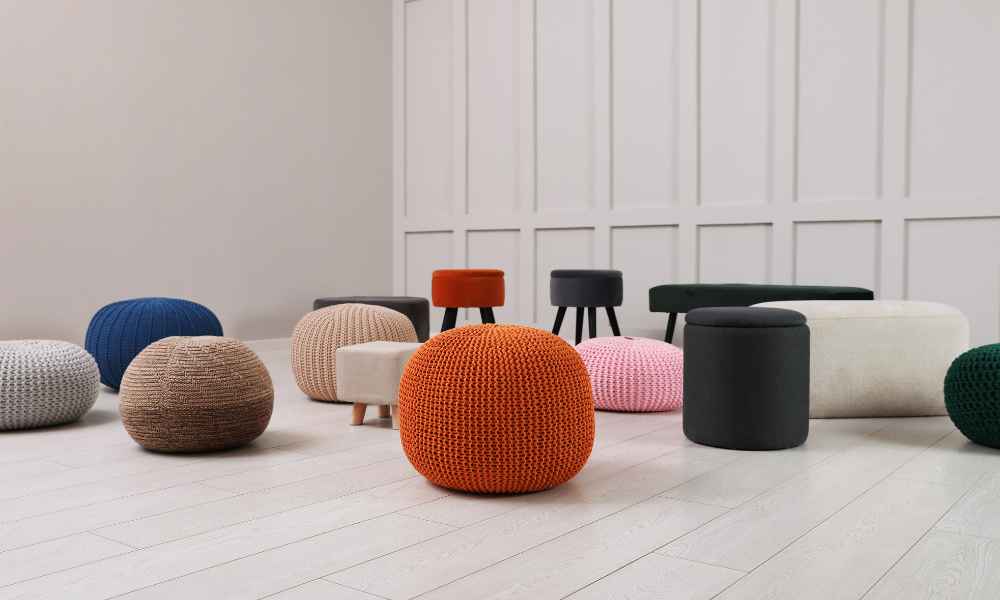A pouf ottoman is a versatile and stylish piece of furniture that can add both function and aesthetic appeal to any room. Whether used as a footrest, extra seating, or even a decorative element, a well-stuffed pouf can significantly enhance your living space. However, achieving the perfect balance between firmness and comfort in a requires knowing how to stuff it properly. This guide will walk you through the essential steps, from gathering the right materials to selecting the ideal stuffing, ensuring your ottoman is not only comfortable but also durable and visually appealing.
Materials And Tools Required

Before you begin stuffing your ottoman, it’s crucial to gather all the necessary materials and tools to ensure a smooth and efficient process. Typically, you’ll need your chosen material, which could range from polystyrene beads, memory foam, old clothes, or even recycled materials. Additionally, having a sturdy needle, strong thread, and a pair of sharp scissors on hand is essential for any stitching that may be required. Some ottomans may also need an inner lining to keep the stuffing material in place, so make sure you have that ready as well. Preparing these items ahead of time will make the stuffing process much more manageable.
Preparing The Pouf Ottoman
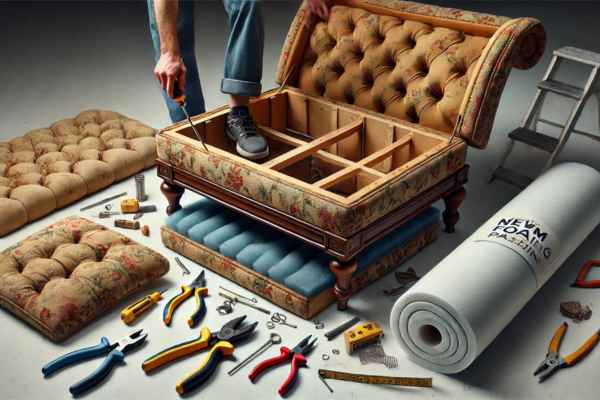
Proper preparation of the ottoman is a crucial step to ensure that the stuffing process goes smoothly and yields the best results. Start by examining the pouf for any existing zippers or openings, which will make it easier. If your pouf doesn’t have an opening, you may need to create one using a seam ripper or scissors, ensuring that it can be neatly closed afterward. Once the pouf is ready, it’s also a good idea to clean it inside and out, removing any dust or debris that might interfere with the stuffing. Ensuring that the is clean and structurally sound will provide a strong foundation for the process, ultimately leading to a more comfortable and long-lasting ottoman.
Choosing The Right Stuffing Material
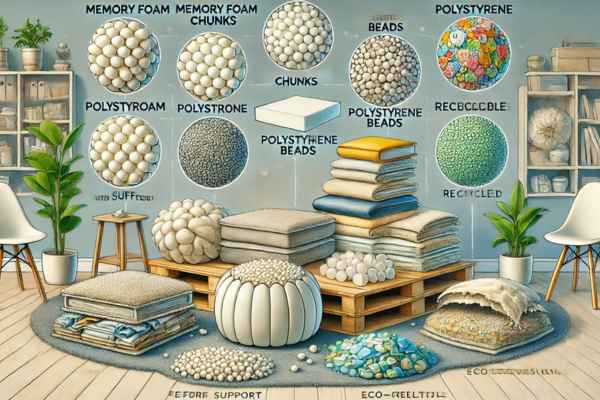
Selecting the right stuffing material is perhaps the most important part of the pouf-stuffing process. The choice of material will significantly impact the comfort, shape, and durability of your pouf. For a firm and supportive feel, materials like memory foam or polystyrene beads are ideal, as they retain their shape well over time. If you prefer a softer, more malleable, consider using old clothes, blankets, or even a combination of different materials for a unique texture. Recycled or eco-friendly options are also available for those who are environmentally conscious. The key is to choose a material that aligns with your desired comfort level and the intended use of the pouf, whether it’s for sitting, propping up your feet, or simply as a decorative piece.
Measuring And Cutting Stuffing Material
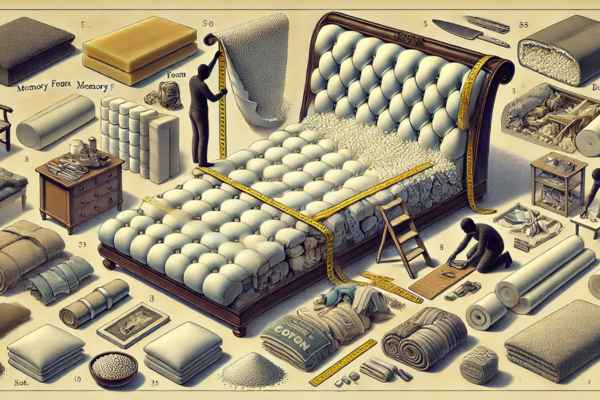
Once you’ve chosen the ideal stuffing material for your ottoman, the next step is to measure and cut it to the appropriate size. This process is crucial to ensure that it fills the pouf evenly and provides the desired level of firmness. Start by estimating the volume of your and then measure out the stuffing material accordingly. If you’re using fabric-based clothing like old clothes or blankets, it’s helpful to cut them into smaller, manageable pieces that can be easily distributed inside the pouf. For materials like memory foam or polystyrene beads, consider portioning them into bags or sections that can be inserted evenly. Taking the time to measure and cut the stuffing material correctly will help achieve a balanced and well-shaped ottoman.
Stuffing The Pouf Ottoman
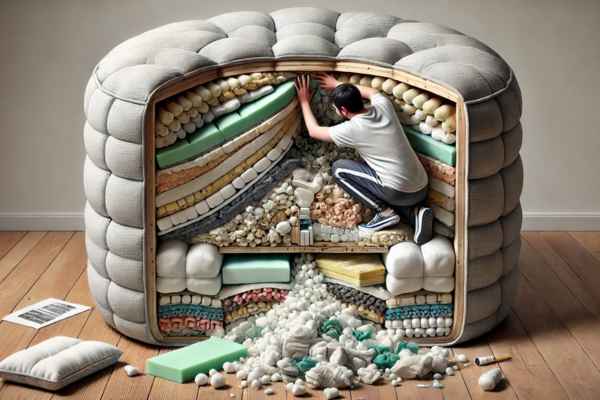
With your stuffing material prepared, it’s time to begin the actual process of filling the ottoman. Start by gradually inserting through the opening of the pouf, making sure to distribute it evenly to avoid lumps or uneven areas. As you stuff, periodically press and mold the pouf to ensure that the material is settling correctly and filling all corners. If you’re using a mix of different materials, layer them thoughtfully to create the desired texture and firmness. For example, placing firmer materials at the base and softer ones at the top can create a comfortable yet supportive feel. The key is to be patient and methodical during this process, adjusting the stuffing as needed to achieve a uniform and aesthetically pleasing result.
Sealing And Finishing
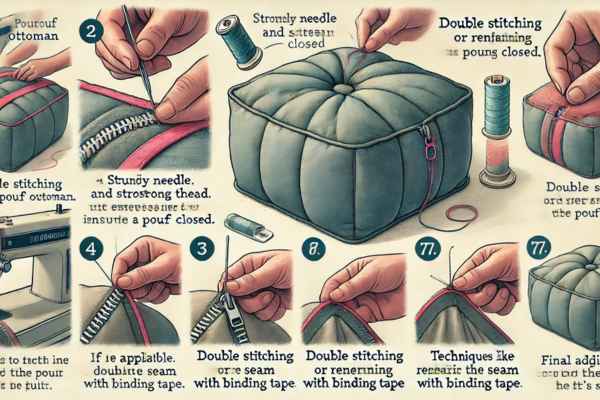
After you’ve filled the ottoman to your satisfaction, the final step is sealing and finishing it. If your pouf has a zipper, simply close it and ensure the seam is secure. For poufs that require an opening to be cut, use a sturdy needle and strong thread to sew the seam closed, making sure the stitches are tight and even. For added durability, consider using a double stitch or reinforcing the seam with additional fabric or binding tape. Once sealed, give the a final inspection, smoothing out any lumps or bumps and ensuring that it maintains its shape. Properly sealing and finishing the pouf will not only keep the stuffing securely inside but also contribute to the overall look and longevity of your ottoman.
Maintaining And Caring For Your Pouf Ottoman
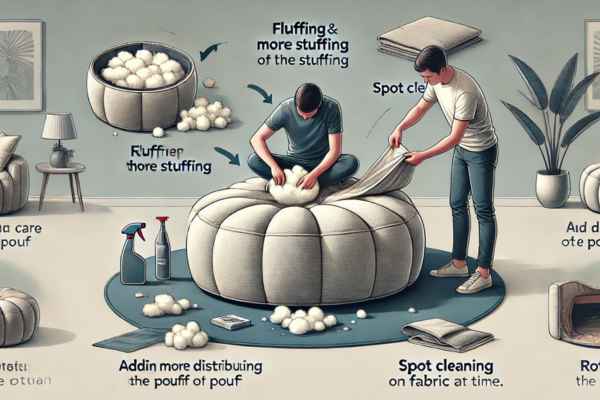
To keep your ottoman looking and feeling its best, regular maintenance and care are essential. Depending on the material used, you may need to periodically fluff or redistribute the stuffing to maintain its shape and comfort. For fabric poufs, spot cleaning any spills or stains promptly will help preserve the material’s appearance. If the becomes too compressed over time, consider adding more stuffing to restore its original firmness. Additionally, rotating the pouf occasionally can prevent uneven wear and ensure that it remains comfortable for years to come. With proper care, your ottoman will continue to be a functional and stylish addition to your home.
Common Challenges And Solutions
Stuffing an ottoman can be a rewarding DIY project, but it’s not without its challenges. One common issue is achieving an even distribution of stuffing, which can result in a lumpy or uneven pouf. To solve this, take your time to layer and adjust as you go, ensuring it fills all areas uniformly. Another challenge is overstuffing, which can make it too firm and difficult to close. The solution here is to gradually add, testing the firmness as you go, and stopping once you’ve achieved the desired feel. If the pouf is underfilled, it may lose its shape or collapse; in this case, adding more stuffing or using a denser material can help. By anticipating these challenges and knowing how to address them, you can ensure a successful pouf process.
Cost And Budget Considerations
Cost and budget are important factors to consider. The price of stuffing materials can vary widely, from inexpensive options like old clothes or blankets to higher-end materials like memory foam or polystyrene beads. If you’re on a budget, recycling household items or using eco-friendly, cost-effective materials can be a great way to keep costs down while still achieving a comfortable pouf. Additionally, consider the size of your; larger poufs will require more stuffing, which can increase the overall cost. Planning your budget ahead of time and exploring different material options will help you create a pouf that fits both your aesthetic preferences and financial constraints.
When To Seek Professional Help
While stuffing an ottoman is typically a manageable DIY project, there are times when seeking professional help may be beneficial. If your pouf is made of delicate or expensive fabric, or if it has intricate stitching that could be easily damaged, a professional upholsterer can ensure that the process is done with care and precision. Additionally, if you’re unsure about the best stuffing material to use or how to achieve the desired firmness, a professional can provide expert advice and recommendations. Finally, if you encounter difficulties in sealing or finishing the, such as issues with stitching or zipper placement, professional help can ensure a polished and durable result. Knowing when to call in a professional can save you time and prevent potential damage to your pouf.
How Much Stuffing Material Do I Need For My Pouf Ottoman?
Determining how much stuffing material you need for your ottoman is crucial to achieving the perfect balance of comfort and structure. The amount required depends on the size of the pouf and the type of material you’re using. For example, a small might need around 3-5 pounds of memory foam or 2-3 bags of polystyrene beads, while a larger pouf could require double that amount. If you’re using recycled materials like old clothes, it’s helpful to weigh them beforehand to ensure you have enough. Additionally, consider the density of the material; firmer stuffing like foam will take up less space compared to lighter, more compressible materials. To avoid running out of stuff midway through the project, it’s always a good idea to overestimate slightly and have extra material on hand.
Can I Use Old Pillows Or Cushions As Stuffing For My Pouf?
Yes, old pillows or cushions can be repurposed as stuffing for your ottoman. This is a practical and eco-friendly option that helps you recycle materials you already have. To use old pillows or cushions, start by removing the and breaking it into smaller pieces. This ensures that the material will be evenly distributed inside the pouf. Be sure to inspect the pillows for any damage or wear that might affect the final result. If the pillows are in good condition, their filling can provide a soft, comfortable texture that is ideal for an ottoman. Just keep in mind that the final feel of the pouf will depend on the quality and type of stuffing within the pillows.
What’s The Difference Between Foam And Fiberfill Stuffing?
Foam and fiberfill are two popular stuffing materials for ottomans, each offering distinct characteristics. Foam, particularly memory foam or high-density foam, provides a firm and supportive feel. It tends to retain its shape over time, making it a durable option for maintaining the pouf’s structure. On the other hand, fiberfill stuffing, often made from polyester, offers a softer, more malleable texture. It’s less dense than foam and can compress over time, which might require occasional fluffing or replenishing. While foam is ideal for a firmer, more resilient pouf, fiberfill is better suited for a plush, cushioned feel. The choice between these materials depends on your preference for comfort and durability.
How Do I Avoid Lumps In My Pouf When Using Fiberfill?
To avoid lumps when using fiberfill as stuffing for your ottoman, it’s essential to distribute the material evenly throughout the pouf. Start by breaking up the fiberfill into smaller, fluffier pieces to prevent clumping. Insert the fiberfill gradually, pressing it down gently to ensure it fills all areas of the pouf uniformly. Periodically check for lumps and adjust the as needed to maintain an even surface. If you notice any uneven areas, use your hands to redistribute the fiberfill or add more to those spots. Properly stuffing the and smoothing out the fiberfill during the process will help achieve a smooth, comfortable pouf without lumps.
Can I Stuff A Pouf Ottoman With Recycled Materials?
Yes, stuffing an ottoman with recycled materials is an excellent way to be environmentally conscious while creating a unique piece of furniture. Recycled materials such as old clothes, blankets, or even shredded paper can serve as, provided they are clean and in good condition. For clothes and blankets, cut them into small, manageable pieces to ensure even distribution inside the pouf. Be sure to avoid using materials that may degrade or create odors over time. Recycled stuffing can offer a softer, more customizable feel and often comes at a lower cost than new materials. By using recycled items, you not only give them a new purpose but also contribute to a more sustainable lifestyle.
Conclusion
Stuffing an ottoman can be a fulfilling project that adds both comfort and style to your home. By understanding the different materials and techniques available, you can tailor the stuffing process to your preferences and needs. Whether you choose to use old pillows, fiberfill, foam, or recycled materials, each option has its benefits and considerations. Proper preparation, even distribution, and maintenance will help ensure that your pouf remains a functional and attractive addition to your space. With the right approach and a bit of creativity, you can achieve a well-stuffed pouf that enhances your living area and reflects your personal style.
